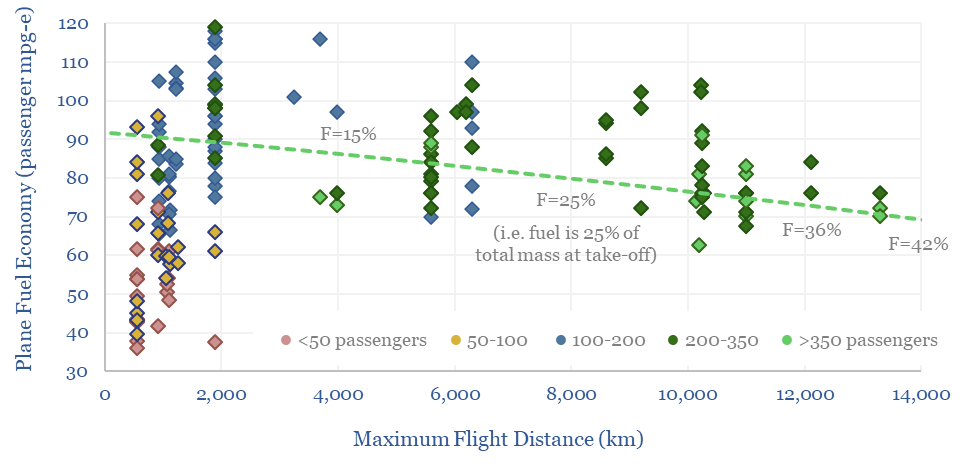This data-file calculates the fuel economy of planes from first principles, using physics to calculate lift and drag, and comparing with actual data from aircraft manufacturers. The typical fuel economy of a plane is 80 passenger-mpg to carry 400 passengers, 8,000km at 900kmph, using jet fuel with 12,000 Wh/kg energy density. What sensitivities and decarbonization opportunities?
This data-file captures the fuel economy of planes, i.e., passenger jets in commercial aviation, starting from first principles in a flexible model, which can be stress-tested, and contrasted with forty years of actual data. You can flex the fuel mass, fuel density, efficiency, passenger count and flight velocity, to derive different ranges and fuel economies.
As a rule of thumb, a passenger jet that takes off with 25% of its weight in jet fuel can travel 8,000km at 900kmph, with a fuel economy of 80 passenger-mpge. Taking off with a larger weight of fuel, 35-45% of the total take-off mass, extends the range to 12,000-14,000km.
How does the fuel economy of planes vary as a function of key input variables? For example, larger planes tend to be more efficient per passenger (chart below). But they also tend to travel further. And each +/- 1,000km of range tends to increase or decrease the fuel economy by around 1.2 passenger mpg-e (chart above).
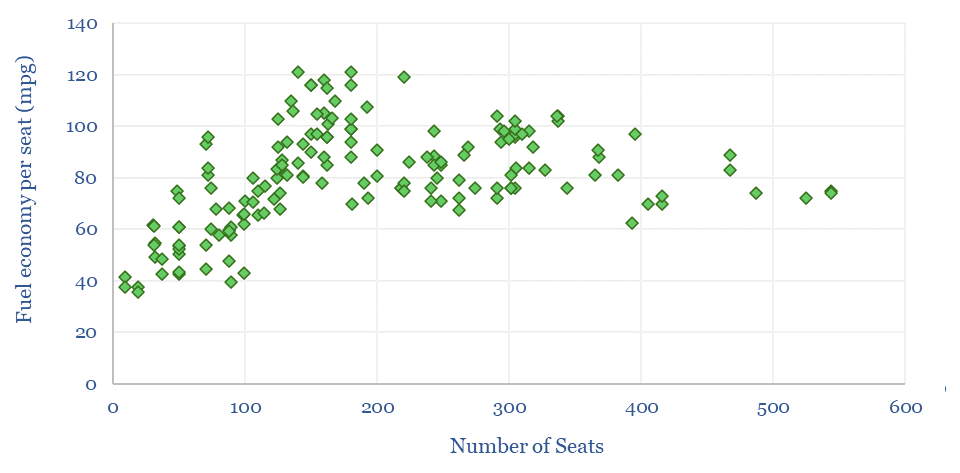
Each 100kmph increase in velocity also degrades fuel economy by around 4 passenger mpg-e (chart below). The key reason is that the thrust needed to overcome air resistance increases as a cube function of velocity. Concorde had a top speed of 2,179 kmph, which all else equal, hurt its fuel economy by -70%, and if we also reflect that Concorde only carried 100 passengers, then its fuel economy would be -92% lower than today’s planes. Conversely, at low velocities, fuel economy degrades because more energy is expended on lift, to keep the plane in the air for longer.
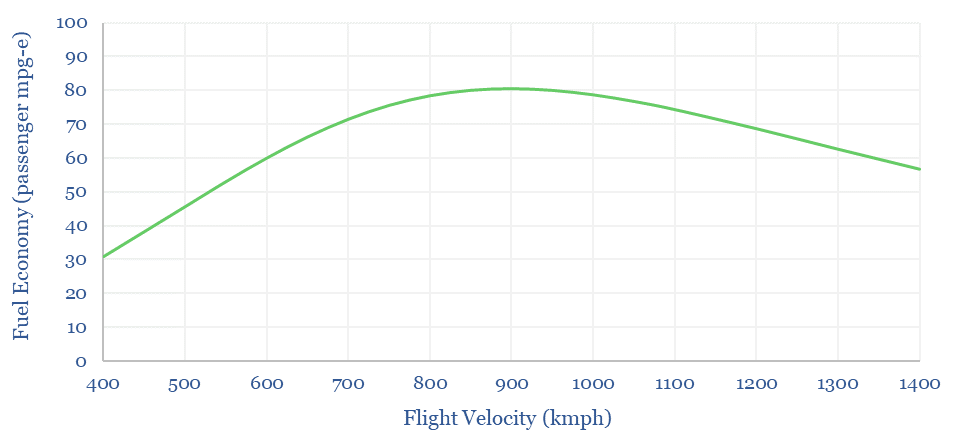
Over the past 40-years, commercial jets have become more efficient at a pace of 1% per annum, while Airbus and Boeing stand out as having made the most efficient aircraft. Data comparing different companies are available in the data-file.
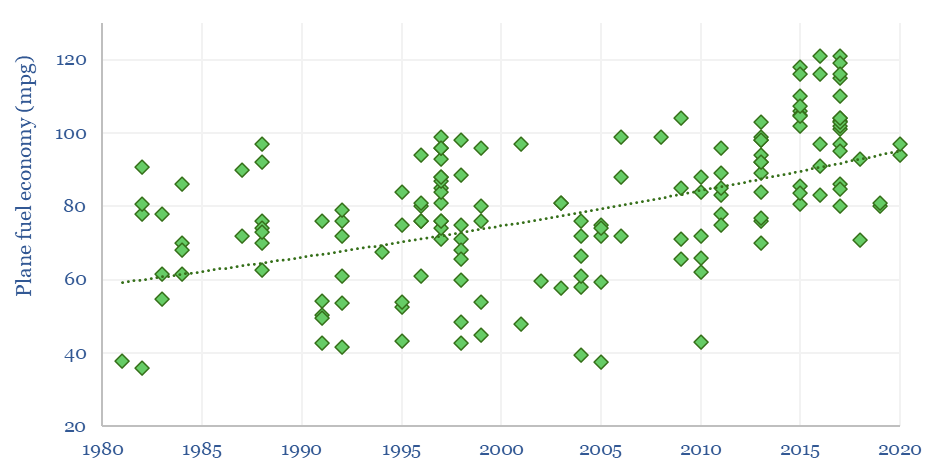
For the future of the energy transition, there may be challenges to displacing jet fuel, which has an energy density of 12,000 Wh/kg. A large plane powered by a lithium ion battery, at 300 Wh/kg battery energy density simply cannot exceed a range beyond 600km, even if the batteries comprise one-half of its mass at take-off.
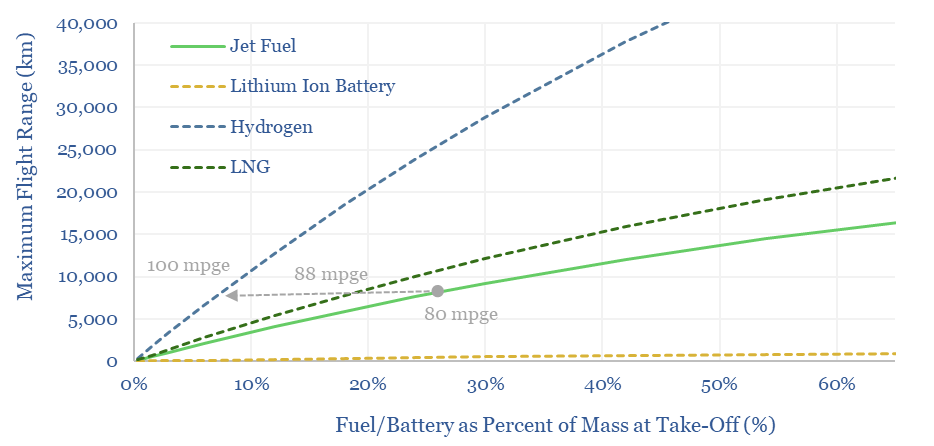
In theory, hydrogen has 3x higher energy density per unit mass than jet fuel. Hence a hydrogen-powered plane would need to carry less fuel to achieve the same range, which could improve fuel economy by 25%. This, at least, is one physics advantage for hydrogen-powered planes.
However, the practical challenges of storing liquefied or ultra-compressed fuel are the reason that the aviation industry has not already harnessed LNG as a potential fuel source, which is 25% more energy dense than jet fuel per unit mass and could have afforded a 10% improvement in fuel economy for the same range.
Across all of our research, we think aviation will be one of the last sectors to decarbonize, as reflected in our long-term oil demand models. We have also evaluated e-fuels (aka SAF), biogas to liquids, alcohol-to-jet and renewable jet fuel (upgraded renewable diesel). The lowest cost and most practical option is to offset the CO2 emissions of continued jet fuel consumption with high-quality nature-based solutions, or even next-gen DAC.
